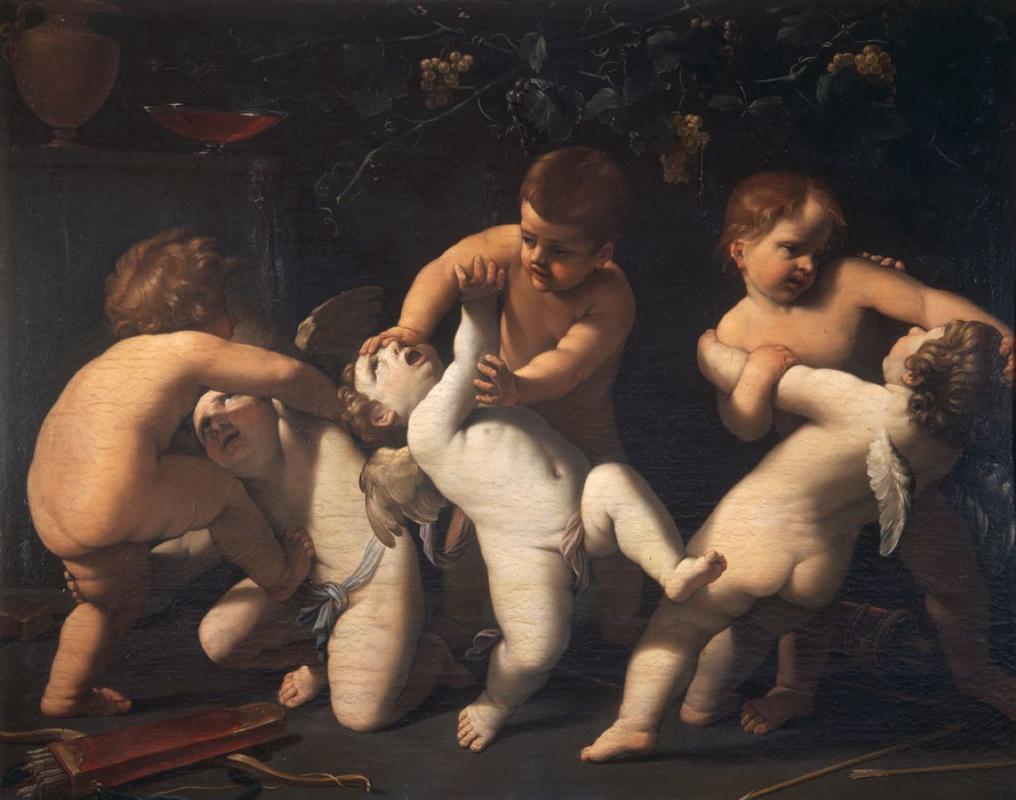More about Putti Fighting

Sr. Contributor
More than just a six-way temper tantrum, Guido Reni’s Putti Fighting is a battle between social classes.
With the tan, wingless putti representing the average-joe and the nobility depicted as pale, chunky cherubs, Reni captures a well-known power struggle between the lower and upper classes. The three tan toddlers are on the offensive, kicking the nobles in the gut, poking out their eyes, and pulling on their hair. The noble cherubs’ frivolities such as wings and well-placed sashes to hide their manhood prove useless against their rough and tough attackers and their defeat is imminent.
Reni’s motivation for painting Putti Fighting likely comes from a dramatic struggle he had with the law and Papal States during his time as an artist for Pope Paul V. Known for his idealistic representation of Madonnas, saints, heroes, and heroines, Reni was highly sought after by members of the clergy to produce devotional images. While working on one such image for Quirinal Palace, Reni continually butt heads with the papal treasurer. The treasurer thought Reni was a slow worker, arrogant, stubborn, and a gold-digger. The treasurer told the artist that if he could earn the amount of revenue Reni was requesting, he would leave the priesthood himself to become a painter. Reni quickly clapped back stating, "I don’t know if you would know how to succeed in it. I do know that I would know how to be a better prelate than you, at least in that part of your work that consists in giving workers their wages.” Pope Paul V’s treasurer is probably lying in his grave still smoking from that burn!
Due to his disgust with the treasurer, Reni left Rome without even saying goodbye to his pal the pope. While he was working on a fresco for the Church of San Domenico in Bologna, Reni received a visit from the cardinal-legate of Bologna on behalf of Pope Paul V. The cardinal demanded Reni to return to Rome to complete the work he had agreed to at Santa Maria Maggiore to which the artist replied he would “rather be torn to pieces.” This infuriated the cardinal who was just trying to do something for his boss and decided to imprison Reni. Before the artist could be captured, Reni went into hiding and planned to leave Italy forever to join the royal court of France or Spain. Enter the savior of this drama: Marquis Facchinetti. Reni’s friend and protector, Facchinetti urged the cardinal-legate of Bologna to rethink his sentence and talked the artist out of leaving the country. Facchinetti, known as a gentle and sweet-talker, convinced Reni to return to Rome, accept his assignment under the pope, and take the high road when dealing with the papal treasurer and ministers. As a thank you for helping him see reason, Reni painted Putti Fighting for Facchinetti. Even though Reni was the bigger man in this debacle with the papal ministers, the symbolic story behind Putti Fighting shows that even after willingly returning to Rome, the artist would have still liked to bash-in the heads of one or two ministers.
Sources
- Malvasia, Carlo C. The Life of Guido Reni. Translated by Catherine Enggass and Rober Enggass. University Park: Pennsylvania State University Press, 1980.
- Sutherland Harris, Ann. “Guido Reni’s ‘First Thoughts’.” Master Drawings 37, no.1 (1999): 3-34. Accessed October 15, 2020. https://www.jstor.org/stable/1554404.
- Sweetser, M.F. Masters In Art: Guido Reni. Boston: Bates and Guild Company, 1903.
- “Guido Reni: Lotta di putti.” Doria Pamphilj. Accessed October 22, 2020. https://www.doriapamphilj.it/portfolio/guido-reni/.











